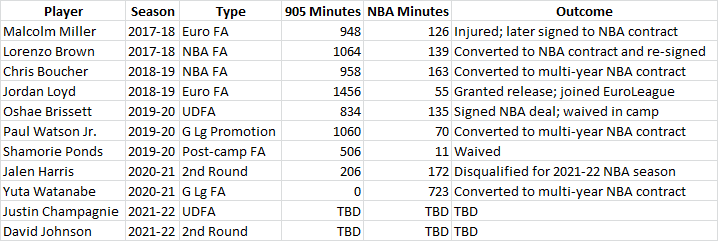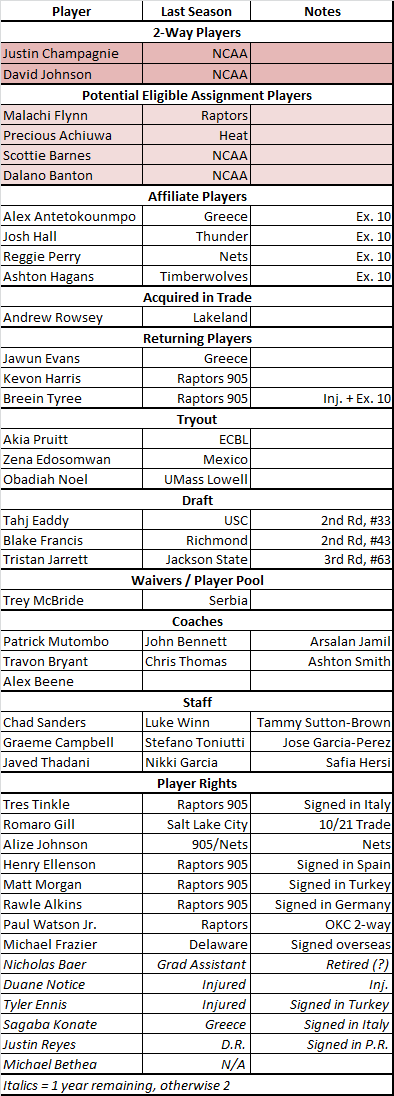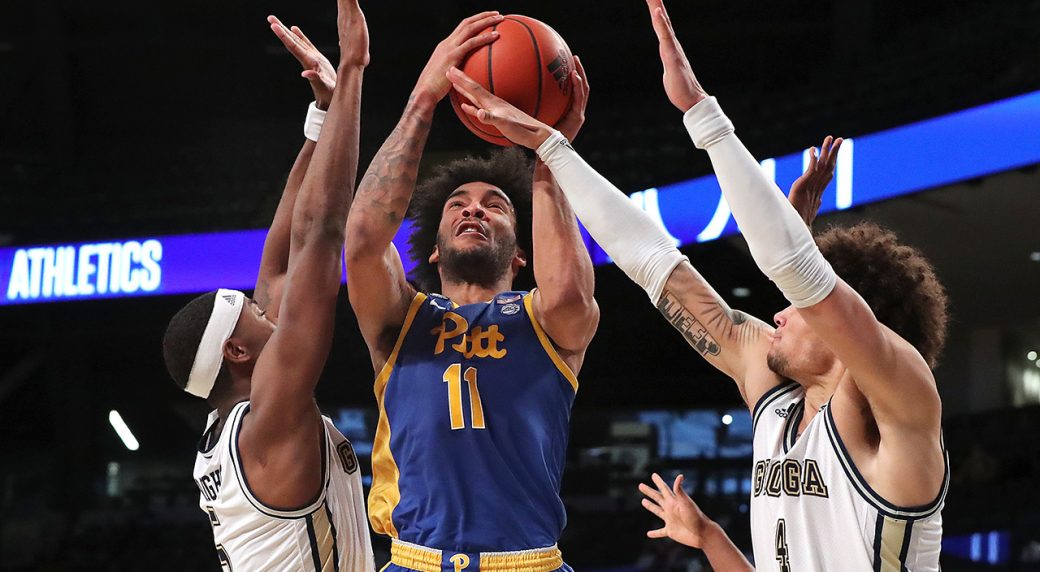For the first four years of their existence, Raptors 905 were paramount to the player development success of their NBA parent club, Toronto Raptors.
Fred VanVleet, Pascal Siakam, Chris Boucher and more came through Mississauga to hone and sharpen their games in anticipation of an eventual NBA role, if things went well. The 905 have been an educator, an incubator and an accelerator.
The last two years, however, have been a challenge.
In 2019-20, the season was cut short due to the pandemic. Even before that, though, the NBA side had dealt with so many injuries that the 905 received just 16 games from NBA assignment players, a comically low number compared to the Raptors’ record-setting approach to assignments in earlier years. In 2020-21, injuries and the nature of a pandemic season lowered that number to just nine. Even the team’s two-way players, Jalen Harris and Yuta Watanabe, only played a combined seven games.
The Raptors are hoping this season represents a return to normalcy. The ability for young players to get extended playing time to work through mistakes and points of emphasis is an important ingredient of the development system. Players have to play to improve, and a G League affiliate right down the road can be a wonderful tool.
The 905 begin their season Nov. 11 at Paramount Fine Foods Centre in Mississauga, Ont. Training camp opened Monday and runs until cut-down day on Nov. 4. What follows is a look at how the Raptors 905 roster is constructed, with an explanation of the different contracts and player types involved.
Eligible assignment players (NBA salary)
NBA teams can assign any player to the G League who is still in his first three seasons in the league, even if they aren’t on a two-way contract. Players with more than three years of experience can be assigned with player and union approval. That’s happened in recent years with a Stanley Johnson looking to get more playing time in or Jared Sullinger on a post-injury conditioning stint.
Assigning a player to the G League does not open up an NBA roster spot or provide any cap relief. The player is simply listed as inactive while on assignment and continues to earn his full NBA salary.

Due to the introduction of two-way contracts and the way the last two seasons have played out at the NBA level, the impact of assignment players has decreased relative to some of the other player categories. Still, these should, on paper, be the best and most advanced 905ers, so long as they can catch up quickly and handle the back-and-forth.
Dalano Banton, Malachi Flynn, Precious Achiuwa and Scottie Barnes are all eligible to be assigned to the 905, plus any veterans who approve, up to a total of three assignments at any one time. The Banton-or-Flynn assignment decision is the most relevant to watch looking ahead a few weeks.
Two-way players (two-way salary, $462,630)
Beginning in 2017-18, NBA teams were allowed to sign two players to two-way deals, contracts that offered an elevated G League salary and allowed a player to spend up to 45 days with the NBA team, during which they’d earn even more.
Those rules have changed over time. For the 2021-22 season, two-way players will earn a set salary of half the rookie minimum and can spend up to 50 games on the active NBA roster.
That tweak has a few trickle-downs. For one, there’s no longer quite as much incentive to convert a two-way player to a full-time NBA contract. The player is already making more money, and 50 games is a lot of NBA usage for a fringe player. You’d be looking at converting a player to reward him or to work out a multi-year deal, not to increase his availability.
This also makes it easier for an NBA team to justify not having a two-way with the G League team. Whereas someone like Jordan Loyd was close to a full-time G Leaguer on a two-way deal, Yuta Watanabe never even practiced with the 905 last season.
Where the Raptors lean on that spectrum this year will come down to the health of their NBA roster. Justin Champagnie impressed in training camp but has a glut of forwards ahead of him on the depth chart, while David Johnson is a clear 905er to start the season.

As a procedural note, two-way spots can be churned without much financial penalty. Two-way players are not eligible for call-ups from another NBA team even while in the G League.
Affiliate players (eligible for Exhibit 10 bonus, $35,000 to $85,000)
NBA teams can tag up to four players who were cut in training camp as “affiliate players.” This serves the dual purpose of stocking the G League team with talent outside of the draft model and keeping the program stocked with players the NBA team wants to help develop and track for future consideration.
For reference, this can only happen with players whose G League rights are unowned. For example, Freddie Gillespie technically would have been eligible here, but Memphis holds his G League rights, and the 905 would have had to trade for those rights. Yes, even though he was an NBA Raptor. NBA rights supersede G League rights, but once a player is waived from the NBA, he defaults to G League rights.
The Raptors worked the roster churn pretty heavily at the end of camp to make sure they had a good group of affiliate players. Technically, the rule only stipulates a player have participated in a team activity at some point in camp, so the Raptors signed players, had them practice once, then waived them for 905 purposes (I have taken to calling these Exhibit 0 players, as they are technically on Exhibit 10 contracts but play zero minutes).

The Raptors only had one player in camp eligible for affiliate player status: Reggie Perry. In addition to Perry, they signed-and-waived Alex Antetokounmpo, Josh Hall and Ashton Hagans.
Antetokounmpo was on the fringes of the draft radar this past summer after a season with UCAM Murcia’s second team in Spain. He played sparingly with Sacramento in Summer League, making him a fairly intriguing unknown to start the year. Hall, meanwhile, spent last season on a two-way deal with the Thunder. He played a single G League game and saw inconsistent minutes at the back of a terrible Oklahoma City rotation, capped by a 25-and-10 in the team’s season finale. Hagans was on a two-way with Minnesota before being waived for violating the G League bubble protocols. He then spent Summer League with the Raptors but didn’t play due to an ankle injury.
The team also signed-and-waived Breein Tyree. While you are limited to four affiliate players, they already held returning player rights on Tyree, so they were able to use this tool to get him the Exhibit 10 bonus to supplement his G League salary.
Although affiliate players have stronger ties to the NBA team and earn a $50,000 bonus if they stay in the system long enough, they remain free to sign with another NBA team if a call-up or two-way contract presents itself.
Acquired in trade (G League contract, $35,000)
The week or two leading up to the start of G League training camps can be quite amusing on the transaction wire.
Because draft picks aren’t particularly valuable and the last two or three spots on a given roster experience heavy churn, the rights to returning players fly around. If you find a player you’re interested in who doesn’t want to be back in the same G League program, or whose team is shopping him, you can sometimes get a solid piece for a low-value draft pick or the rights to a player you don’t intend to bring back.
For example, the 905 acquired Paul Watson Jr. for the No. 4 pick in 2019; Watson eventually played his way on to the NBA team, while the No. 4 pick has become a solid, if unspectacular, G League rotation player (Tyler Hall).
The 905 are hoping to strike gold in a similar way with a pair of trade additions to the roster. As part of a five-team trade, they acquired sharpshooter and former Raptors Summer Leaguer Andrew Rowsey, giving up a 2022 first-round pick in the process (they recouped that pick by dealing the No. 7 pick in this year’s draft for a second-rounder and a future first). The 905 also added Trey McBride following the draft. McBride spent three seasons at D-II Northwood and split 2020-21 between Macedonia and Serbia.
Returning players (G League contract, $35,000)
G League teams hold rights on their former players for up to two years after they last played for the team. Often, that doesn’t end up mattering much, as players head overseas permanently, are traded or earn NBA call-ups with other organizations. In other cases, it’s a way to add some stability to a system that turns over almost entire rosters year-to-year.
Tyree is the big-ticket returner, which is why the Raptors gave him the Exhibit 10 treatment mentioned earlier. Before tearing his ACL, Tyree was earning rave reviews for his tenacious defence and may have received some late-season call-up attention if healthy. He will miss the start of the season but should be a major rotation piece when healthy.
Tyree is joined as a returner by Jawun Evans and Kevon Harris. Evans had a solid 2019-20 with the team and has 56 games of NBA experience, offering some steadiness at the point in an environment that really needs it. He played eight games in Greece last season after signing into the league late. Harris, meanwhile, was the 905’s first-round draft pick last year. Undrafted out of Stone Cold Stephen A. Austin in 2020, Harris has only played 68 minutes for the 905 and 89 minutes in Croatia since graduating.
Local tryout players (G League contract, $35,000)
Teams can use up to four “local tryout” slots to bolster their camp rosters. The local tryout name is a misnomer, as it’s effectively just a way to pre-claim guys for camp who would otherwise be at the back of the draft mix. Thirteen such players have played for the 905 – including Kaza Kajami-Keane, who was too good for the designation to begin with – including new assistant coach Ashton Smith in the team’s inaugural year.
The 905 are bringing three tryout players to camp this year: Akia Pruitt, Zena Edosowman and Obadiah Noel. Pruitt played four years at UNC-Pembroke and was most recently with Charlotte of the ECBL. Edosomwan is a Harvard product who was last playing in Mexico. Noel, the likeliest of these players to make the roster, is an undrafted rookie from UMass Lowell who has flashed real shooting ability, just inconsistently.
Draft picks (G League contract, $35,000)
Is the G League draft a helpful way to add talent? Uh, maybe look away.
Yup! Aaron Best and Antwaine Wiggins are the notable successes, a few others have at least seen playing time, but pre-pandemic seasons this is what the G League draft returns looked like pic.twitter.com/9ru9pwpytI
— Blake Murphy (@BlakeMurphyODC) October 22, 2021
Last year’s draft was better due to a number of players, like Gary Payton Jr., being available on one-year loans from teams who chose not to participate in the bubble. This year’s class was quite weak, with maybe a dozen intriguing names and most teams either targeting players with existing ties to the franchise or honing in on a specific skill in the hopes that something sticks.
The 905 went the latter route, drafting shooters Tahj Eaddy and Blake Francis and reigning SWAC Player of the Year Tristan Jarrett. Those three players will be pushing Noel and Gill for the final two roster spots.
Overall construction
Here’s where the roster and staff stand heading into camp:

The 905 will have 17 bodies in camp, barring an assignment from the Raptors – both two-ways, their four affiliate players, their three returners, two players via trade, and six via tryout and the draft. The two two-ways and 10 G League players will make the final roster.
Those decisions must be made by Nov. 4, with the 905’s season beginning Nov. 11. We’ll have regular check-ins on the status of any rising 905ers and the progress of the Raptors’ two-ways and assignment players.

